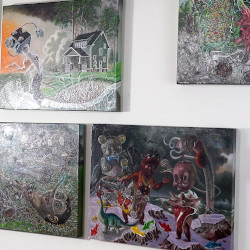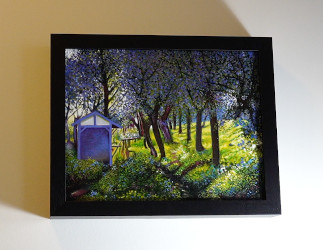






Index:
1) Introduction
3) Art Criticism
3) Intrusive Thinking and Creativity
4) The Role of Missing Information in Creativity
5) Art and Algorithms
6) Art, A.I., and Culture
7) Autism and The World
8) YouTube Channel and Miscellaneous
Studio Photographs and Notes: Here are a few photographs of my work environment. Notes for my Inventing Landscapes with Color Pencil class, which is offered through Ivy Tech Community College, are seen on my work table in the middle set of images, while the last photographs are from classroom settings before 2021. I executed chalk drawings for instruction initially, and later switched to dry erase markers, as shown in the last two images. I have drawn countless drawings over the years for classes, and because I did own a smart phone at the time, I had no practical camera for recording them. My drawings may be compared to Buddhist sand paintings, but someone other than myself erases them.
Fuchs Dystrophy and Cataracts: Due to the development of cataracts and Fuchs Dystrophy, I gave up my drawing classes around 2022. Fuchs is a corneal eye disease that will eventually require surgery, but cataracts have been the more pressing concern for me. My cataracts were successfully removed in 2024, and my vision is greatly improved. My final method of drawing instruction was to use a projector, where students drew along with me. The below image was created in this way.
Reflections on The End of My Time as An Art Instructor: Like many MFA graduates, becoming a painting/drawing instructor was not on my radar after graduation. And yet, my path to becoming a community instructor was an uncrowded one since obtaining a similar entry level position at a four-year college was never going to happen for me.
First, there were my antisocial (autistic) tendencies, which denied me access to an inside track adjunct professorship. And then there was the brutal fact that colleges had no more interest in my surreal art than they had in my gender or skin color. These latter conditions may not have been firmly rooted in 1988, but they were in play, as fellow art grads hinted to me at the time. Merit is rarely the deciding factor in hiring decisions for fine art departments. Moreover, the postmodern aesthetic, which has contaminated everything in this field, has rendered any such judgments on merit null and void. Any remaining criteria is predisposed to abuse.
More essentially, MFA graduates, vainer than myself, would never accept the job that I have performed over the last twenty-six years as a continuing education instructor through a two-year community college.
The job pays too little.
This lack of money and prestige made me ideally suited for this job because I could protect my personal creative projects from the grinding influences of a full-time academic career, where I would be required to teach more and perform other duties. Continuing education does not demand fidelity. It does not require me to “stay in my lane,” so to speak. I have had the time—and energy—to branch out into comics, music composition, and creative writing.
Two art degrees notwithstanding, I am a self taught artist. My method of teaching painting proceeds from how I learned, which was part-to-part: i.e, autistic. This approach has worked well for 26 years of teaching. Had I been hired to teach at a college, this unorthodox approach may not have been well received.
The crown jewel for any college professor is to land a gig in a graduate program, where it is more like counseling with one’s colleagues than teaching a mixed bag of undergrads. There is a reason why tenured professors do not teach freshman classes: They have paid their dues, and so have been liberated from the Sisyphean struggle of repeating themselves endlessly in lecture halls before an onslaught of new students. Make no mistake, most artists would prefer making art to teaching; and of those who find fulfillment in teaching, few find it teaching freshmen taking electives.
Still… I have achieved something similar to the graduate school advisor effect by cultivating repeat business with my continuing education students. Many of whom have been with me for years.
A Philosophy for My Art: Attending college and graduate school as a “fine arts artist” was more a holding pattern than a career choice. A commuter college (Memphis State University) was one type of outsiderism, while having autism was another. Indiana University was regarded as one of the five top programs for painting in 1986, and I got into the graduate program due to a professor at MSU having a daughter on the graduate selection committee. It was never a question of talent but connection, which is generally the case within competitive programs. Still, I was grateful for my opportunity to observe and mix with graduate students from elite institutions. I discuss my arts education in detail on my Porfolio pages.
I was accused of creating ‘kitsch’ when I first entered graduate art school and, truthfully, there was no irony or self awareness in how I approached my shatter-shot artmaking. Had my attraction to converting consumer products into cubist compositions taken a purer form, these projects would have fallen under the approval of the Pop Art umbrella. However, it was not clear to colleagues and instructors that I was doing anything like this intentionally, especially in how I sometimes used silicon caulking and tin foil as embroideries.
 Typical 3-D style painting from my BFA era, which would have received the kitsch label in my MFA era.
Typical 3-D style painting from my BFA era, which would have received the kitsch label in my MFA era.
Academic styles mostly escape the kitsch label by being predictable enough to check necessary boxes: The work is not so imaginative that it intrudes on the unimaginative viewer’s experience. Low expectation allows the viewer to insert their own opinions into the dead air around an uninspired painting. One can chinwag cleverly over a plastic cup of box wine and feel the equal of any artist on display. The unstated premise—the unescapable reality—is that current art is ‘derivative,’ and so each attendee joins in this chorus of veiled condemnation as they claw their way to the summit of despair. This is a cynical view of the process, but there is no other way to describe why the art world never evolves out of its stagnancy.
Fine art painting involves limited vocabularies, with each offshoot in style being its own limited vocabulary. When viewed with a wide lens, these restrictions are necessary since fine arts artists, in each category of interest, are more alike than different in terms of their entry level skill. It is a given style that sets the limits, which most painters work within comfortably. When individuals are attracted to the same pursuit, the jumping-on-point cannot be too steep.
With maturity, I find pleasure in many figurative-abstract and abstract styles. However, when presented with a plethora of accomplished paintings in these styles, it is impossible to rank them. Still, had I less curiosity about the breadth of creativity possibilities before me as a young man, I would have settled into one of these comfortable ruts, but it is hard to distinguish one’s self on such a well-rehearsed field of play.
Finding Collectors for My Work: To date I do not sell many works. If one sells one’s art for too much, then there will be few buyers. If one sells one’s art for too little, then the art may be viewed as a less valuable investment, and so its provenance receives less regard. This sets it sinking down an indifferent food chain where no one may care where it winds up.
The problem of building up too much unsold art inventory did not occur all at once for me. It was more like the slow drip of a faucet over time. In 2010, this inventory was clutter for a small apartment, to be sure, but there was not much of it. I began to downsize canvases going forward. Presently, I create two or three paintings a year, but even this rate is slowing down. (Paintings in my possession number less than fifty.)
The best solution to my purchaser dilemma would be to place my entire estate in a museum collection—even if I have to give the art away.
Copying Willem de Kooning: I have copied few works of art in my life, and none post-maturation. However, I thought that, should I do it again, I would copy someone I both admire and whose work is different from my own. As a gift to my sister, I made a small version of Willem de Kooning’s Untitled II.
What I like about de Kooning’s abstract-expressive oil paintings is how he excavates, almost at the very end of his process, with semi-transparent white. The effect creates misty veils of negative space that weave through his elements. This technique is common among realist landscape painters who used diffuse light filtering through tree branches to soften up the space. Often this is done late in a painting.
Here is a comic I made some years ago on the subject of Willem de Kooning.
Cataracts, Claude Monet, and Mistaken Identity: It is a apropos of something that the first painting I chose to create after receiving my cataract surgeries should be a copy of a painting I believed (falsely) to be by Claude Monet. Cataracts greatly degraded his painting in later life.
As it turns out, this Impressionist homage is by Lilla Cabot Perry, an American painter who mentored under Monet. A reverse image search would have produced information about her authorship of this painting, although this Google feature was still relatively new in 2013.
 “Giverny Landscape in Monet’s Garden” by Lilla Cabot Perry.
“Giverny Landscape in Monet’s Garden” by Lilla Cabot Perry.
I have often told my students that I would make a master forger should I ever turn my talents to a fruitful occupation.
 My version of Perry’s Monet-inspired landscape.
My version of Perry’s Monet-inspired landscape.
To Frame or Not To Frame: I prefer painting the gallery wrap on my own canvases and leaving them unframed. (See below.) Gallery wrap canvases are more acceptable these day, even in New York galleries. It saves the artist the exorbitant expense and trouble of using frames.
Given Postmodernism, and the deconstruction of the relationship between art objects and the spaces they occupy, frames seem somewhat old-fashioned, arbitrary, or even intrusive. And yet, there is the expectation that they should exist.

I have no faith in my selection of frames. Whenever I try to visualize them surrounding my paintings, they never seem to work. My paintings are dense, and their lineage to comicbook art further decrease their depth of field. Frames crowd a shallow field, and so add little.
 This blog entry has been turned into a YouTube video. See my Video portal page for a link.
This blog entry has been turned into a YouTube video. See my Video portal page for a link.
Copyright © 2024-2022 michael l. teague all rights reserved.